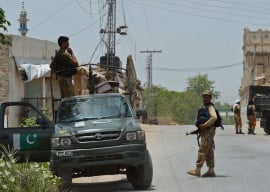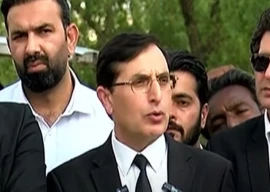
In Karachi, a new transport system is in the making. In this metropolis, where absence of subways or metros leaves the citizens with no other inexpensive option than to board the old, rusted passenger buses, finally there may be an alternative which allows them to shun the rickety coaches that take forever to reach one part of the city from another.
Construction is about to start on a dedicated bus lane for the Bus Rapid Transit System (BRTS). The 22.4-kilometre track from Dawood Chowrangi in Landhi to Numaish Chowrangi in Saddar is expected to reduce the travelling time by half in this ever-expanding city. Another couple of months remain in its paperwork but the actual service will become available before 2014.
The city administration – Karachi Metropolitan Corporation (KMC) – thinks the project is imperative, considering the worsening traffic chaos.
“This is the way forward for Karachi,” says Anwer Baig, the director of Karachi Mass Transit Cell (KMTC). “It is the quickest and the most affordable way to travel around a city, which is fast expanding.”
With fuel prices soaring and car parking increasingly becoming a headache, the authorities have shown renewed interest in fixing the public transport system. The BRTS envisages around 200 large articulated buses running on either sides of the road’s green belt at an interval of few minutes.
“The median will be dedicated for buses only and the New Jersey barriers will be placed parallel with the track to stop motorcycles and cars from coming in,” said Baig.
The first BRTS track has been named Yellow Line. Once it is complete, around 13,000 passengers will be using it every hour.
The official said that the success of the project will centre on speed, convenience and privilege. While the average speed of traffic in Karachi is between 14km and 17km per hour, the rapid transit will offer the travellers to travel at 25km to 30km per hour. At present, the public transport buses are the most used medium of commuting but the most disliked also. Passengers are forced to ride atop the buses due to congestion and there are no speed regulations.
The passengers using rapid transit will have some privileges. At many intersections on its route, the buses will get longer “green time” – which means the people in private cars would have to wait at the stops a bit longer.
“We cannot have a dedicated track on the entire length of a route like Sharae Faisal. Rapid transit buses will mix with regular traffic before re-entering the tracks. This is done everywhere in the world but the traffic needs to be regulated at such points,” Baig said.
“Intelligent traffic lights will have to be installed for this purpose,” he said. “The role of traffic police to make [rapid transit] a success remains imperative.”
Too grand for Karachi?
The authorities believe there is every reason to be optimistic. “Many cities around the world are rapidly adopting this solution,” says Baig, who has been associated with the project since its inception.
Previously, many government-sponsored transport projects have come to a standstill. The poor condition of Green Buses and Metro Coaches are an example of the official apathy towards the issue. Even the rapid transit project was conceived a couple of years ago, but no headway were made until recently. But the KMTC director says some things have changed for the better this time.
“We have the Karachi Master Plan 2020 and a separate transportation plan. The Public Private Partnership Act 2010 is already in place, so we have legal cover,” he said. “Things will go smoothly.”
The authorities’ seriousness can be gauged from fact that the KMC is finally inviting expressions of interest (EOI) to carry out a feasibility study of the Yellow Line. An amount of Rs500 million has already been set aside for the rapid transit buses in this year’s budget.
It’s all business
The Yellow Line has been conceived on public-private partnership to make sure government has some role in public transport. According to officials, the cost of the project is estimated at Rs2 billion, which means Rs20 bus tickets would be enough to sustain it. “Any company which runs the system can easily good earn money without pushing up fares,” said another official. “There are 21 stations along the route. They can use them for earning advertisement revenue. There are many other ways to make use of the space.”
Design
The stations will be built at the median of the road and will be four metres wide. Once a bus leaves the station, the median’s width will reduce to 0.75 metres to provide enough space for the buses to run on the roads. Each bus track is 3.5 metres wide.
The stations will be connected to sidewalks with a pedestrian bridge to let people coming from both sides to come onto the platform. The platform will be at an elevation to let passengers easily walk onto the bus without using stairs.
According to initial details, the buses will not be air conditioned, which has been done mainly to keep costs low and the fare within affordable limits. There is one problem, however. “People will have to get used to using the right-side door of the bus,” Baig says. “This means the driver’s side as the platform is in the middle of the road.” A Japanese firm – Japan International Cooperation Agency – has carried out detailed studies for two more rapid transit tracks. Six BRTS have been proposed for Karachi.
Published in The Express Tribune, August 2nd, 2012.
COMMENTS (11)
Comments are moderated and generally will be posted if they are on-topic and not abusive.
For more information, please see our Comments FAQ




















1713889672-1/Plastic-waste-(2)1713889672-1-270x192.webp)

















Karachi is a neglected city, meant only for earning/loot-maar and not for owning, nothing will be done for its development, schemes will remain on papers.
Just create above ground train system and save public money on fuel/transportation mafia. Also it will generate money for city like no other project. The country where no one cares about traffic sign and marked lanes, this project has Failure written all over. In rush hour everyone will try to get in the bus lane to cause massive jams.
What`s about 500 CNG buses plan for Karachi, announced about 4 years back by CM of Sindh? This plan will also meet its fate. Karachi is in the grip of very strong and influential transport mafia? Have they approved this plan?
@Zabdesk: sir we can hardly maintain sewage lines which are a couple of feet below let alone subways :)
This is just a lolly pop. I do rememeber in some around 1995-1996, the Rani Shaheed BiBi has laid the marble stone at near Tower for the work of some rapid transport system, then a novel idea by MQM led citigovernment for elevated expressways, and many more by various regimes but all in vein.
The only solution to this transport congestion iis to go underground. Kindly study the cities like Karachi throughout the world.
This is the perfect solution. We donot need to invest in metro rails which cites a whole new development (or re-development) of infrastructure. Instead, improving for the bus networks is the correct call. Now only if this project gets to its completion.
Well it is good start. All over the world transport is divided into BRTS, Metro, Taxi and Private cars. I don't agree with loss of jobs point, it is not a zero sum game, that one loose and one win. It is about collaboration and partnership. I can give you example of Dubai when Metro introduced all Taxi drivers and private bus contractors thought that it is the end of their income. On the contrary, they are making more money than before as due to Metro new routes have been invented and pattern of passenger traveling has changed dramatically.
Also, the private contractors are working with RTA and they have more business. Similarly these new buss system should be partnered with Private operators but on strict conditions i.e to maintain the vehicles up to standard and only educated staff is hired to operate.
I think it is duty of KMC to take everyone on board and explain the process.
It is high time that transport system throughout Pakistan should improve.
This experiment already made by painting BUS LANE on through out Shahrah-e-Faisal and was not successful. As nobody cares and I am sure the new BRTS is plan to suck public money only nothing else unless there is strict implementation on existing laws.
Great idea, but given the Pakistani penchant for cutting corners and just doing the bare minimum I have serious concerns. A proper metro rail system is whats actually needed, Above ground parallel to existing major thoroughfares and arteries. Start it now with a goal of completion in 10 years, seek local as well as outside guidance. Bangkok provides an excellent example of an old city with population density issues that has been able to incorporate an elevated metro system.
start all the projects near elections, so that it seems like u r doing something.. anyways, a good plan..i hope it is executed and finished on time.
Well for Lahore this project is OK but for Karachi this will lead to some problems so a thorough work needs to be done. On BRTS tracks news buses like Lahore will run but everyone knows that who owns the transport sector and It will result in loss of thousands of jobs and it could lead to tensions. So I think the existing bus drivers and transport sector should be made a part of it so that new buses will not be able to the loss of thousands of Jobs and it could lead to another ethnic tension then.